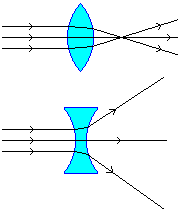
Home | Raytracing Reference | Help
A lathe, originally, was a tool used to shape objects by shaving them as they turned round and round. If you have table legs with round cross-sections, they were probably made with a lathe. A computer graphics lathe object is used to model shapes just like this. Lathe objects are surfaces of revolution: they have round cross-sections and arbitrary longitudinal sections.
A lens is a transparent object used to converge or diverge light rays through refraction. The most common example of a lens is a hand lens or magnifying glass. Spectacles use more complex lenses. Binoculars, telescopes and cameras use combinations of lenses.
There are two broad classes of lenses: convex (converging) and concave (diverging). These are illustrated below.

The point through which a ray must pass if it remains parallel to its original direction after refraction is called the "optical centre" of the lens. The point to which a parallel beam of light converges after passing through a convex lens is known the "first principal focus" of the lens. The point from which a parallel beam of light appears to diverge after passing through a concave lens is known as the first principal focus of this lens. The "second principal focus", in both cases, is the point towards which a beam of light must converge if it is to be rendered parallel after passing through the lens. The distance from the optical centre to the first principal focus is called the "focal length" of the lens: it is positive for a convex lens and negative for a concave lens (hence the plus and minus powers of spectacle lenses). If an object is viewed through a lens, we observe that the position of the image of the object is different from that of the object itself -- it may be upside-down, or shifted forward or backward. The distance of the object from the optical centre is called the "object distance". The distance from the image to the optical centre is called the "image distance". All distances are positive when measured in the direction of the incident light and negative otherwise. Object distance (u), image distance (v) and focal length (f) are related according to the equation

The "power" of a lens is the inverse of its focal length (1/f). It is usually measured in dioptres (1/metre).
See also: focal blur
A lighting model can be either a system of modelling and positioning lights or a way of calculating surface apppearances based on lighting data. In the first sense, a good example is the Warn model. In the second sense, examples are the approximate empirical models used to calculate diffuse and Phong intensities. Broadly speaking, the entire raytracing algorithm, as well as global illumination methods like radiosity, can be referred to as lighting models because they simulate the physical phenomena of multiple reflections and refractions of light in a scene.
A light source is an object which emits light (or more generally, radiant energy) on its own. Most graphics applications model light sources as point objects, but they can actually be points, lines, areas or volumes. It is convenient to think of the latter three as aggregates of point sources. However, some algorithms (including raytracing, when luminous objects are present and all surfaces are perfect reflectors) do not make this approximation.